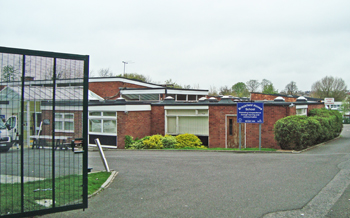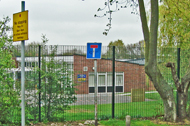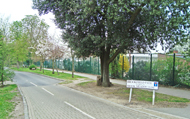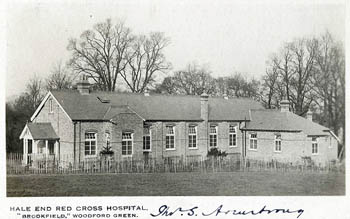Military convalescent. Later, orthopaedic
The Hale End Red Cross Hospital for convalescent servicemen opened in 1915 in the grounds of Brookfield House, Oak Hill. The owner of the house, Mr. Thomas Sutcliffe Armstrong, had donated the land, as well as contributing to the cost of the building, in memory of his son who had been killed in the war. Mrs Henry Young of Larkshill Farm, Chingford, gave £100 for the linen, and further funds for the upkeep of the Hospital were given by Mr. Charles Merriam of the Xylonite Company (xylonite is better known by its American name as celluloid).
The Hospital, which also became known as the Brookfield Red Cross Hospital, had 30 beds. It was equipped and maintained by the Hale End District Association, which had been founded as a ratepayers' association in 1909. The Hospital was administered by a management committee according to the rules of the Red Cross Society.
The Hospital closed in February 1919 after the war, and the building was then used by the Walthamstow Urban District Council to accommodate patients waiting to be transferred to the Walthamstow Isolation Hospital in Chingford.
In 1922 the building was bought by the Council and, in 1923, became a centre for crippled children - the Brookfield Orthopaedic Hospital and School for Crippled Children - which was governed by a council of representatives from the Essex local authorities. The governing body consisted of 4 members from the Walthamstow Borough Council, 3 from the Walthamstow Educational Committee, 3 from the Public Assistance Committee, 2 from Essex County Council, 3 from the Connaught Hospital and a few from various welfare organisations. The patients were paid for at a rate of 2 guineas (£2.10) a week.
The Hospital had been founded as a result of the difficulty experienced in obtaining treatment for crippled children, particularly in the Walthamstow area. It had 30 beds. Children up to the age of 16 years were treated, referred from local authorities, Public Assistance committees and other Poor Law authorities. The main conditions operated on were for anterior poliomyelitis, spastic paralysis, congenital defects, torticollis, genu varum or genu valgum due to rickets, congenital dislocation of the hip and osteomyelitis.
In 1934 Essex County Council considered building a new hospital on land adjacent to the Hospital. The Hospital's Board of Governors agreed in principle to sell its buildings and site provided that facilities for treating orthopaedic patients would be available in the new hospital and that Walthamstow children would receive priority admission. (This scheme never happened.)
In 1935 the average stay of each patient was 36 days, compared with 131 days in 1934, while the average cost per in-patient per week was £2 3s 5d (£2.17) with an additional 5s 6d (27p) for schooling in 1935 (£2 4s 5d (£2.22) plus 7s 2d (36p) schooling in 1934).
Since its opening in 1922, some 781 children had been admitted by 1935 and 955 operations performed.
Although the schoolroom was improved and re-equipped in 1935, in 1936 the residental Hospital School moved to new premises at Hale End, where it was named the Hale End Open Air School (it was renamed Wingfield House School in 1957).
The Hospital closed in 1939, at the outbreak of WW2.
Present status (April 2009)
In 1956 Brookfield House was renamed Spackman House, a hostel for the elderly owned and administered by Essex County Council.
At the end of the 1950s the Hospital was demolished and a new school built on its site for physically handicapped children. The Brookfield House School opened in 1964, with pupils being transferred from Wingfield House School.
Spackman House closed in 1990. The building was sold and later demolished (but, apparently, the porch of the original house was saved and graces the clubhouse of the Wadham Bowling Club). A small housing estate now occupies the site.

Brookfield House School, as seen from the east gate on Alders Avenue.


The School from the west.


The School, as seen from the corner of Alders Avenue and Brookfield Path (left). Brookfield Path leads to Brook Meadow Close, once the site of Brookfield House (right).

Hale End Red Cross Hospital.
(Photograph reproduced by kind permission of
robmcrorie - flickr)
Dunhill ML 2005 A History of Highams Park and Hale End. Chichester, Phillimore & Co.
http://deletedcatharak.uk
www.british-history.ac.uk
www.highamspark.waltham.sch.uk
www.nationalarchives.gov.uk
Return to home page